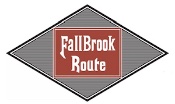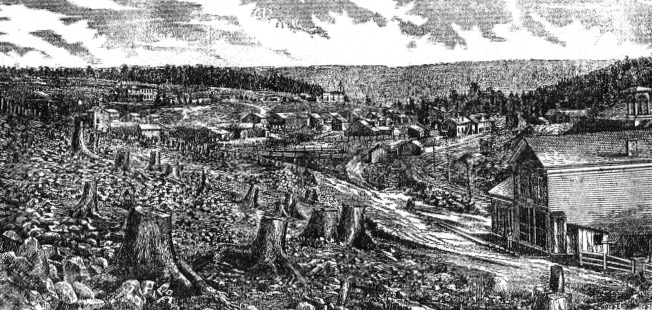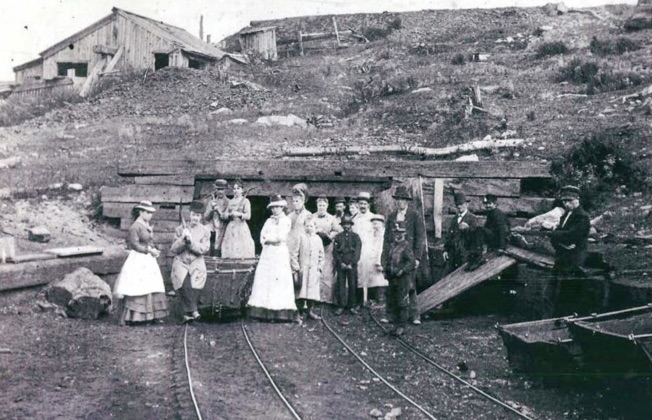
The Village of Fall Brook, Pennsylvania
Fall Brook was laid out and founded by Hon. John Magee, late president of the Fall Brook Coal Company in 1858, and incorporated in August, 1864. It is one of the the principal mining towns in Tioga county. The business of the inhabitants is exclusively devoted to the mining of semi-bituminous coal, from two to three hundred thousand tons being annually mined and shipped to market. It is the terminus of the Fall Brook railroad. The air is pure and healthy, and some of the finest mineral springs in the state are to be found here. (An Illustrated History of the Commonwealth of Pennsylvania, 1876, p 1108)
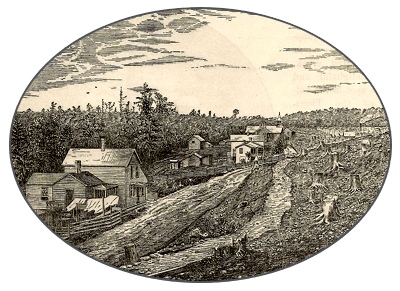 John Magee, and his son Duncan, obtained a contract from Hon. C. I. Ward, of Towanda, Bradford County, conferring the right to explore for coal on the lands of Mr. Ward, situated on the waters of Fall Creek (or Fall Brook, as it has subsequently been called,) and the Tioga River, six miles east of Blossburg. They met many obstacles, but in 1857, they found a large quantity of coal. Under the direction of Duncan S. Magee, drift No. 1 was put in on the Fall Brook side of the mountain. A survey was commenced for a railroad from the Tioga Railroad at Blossburg, to the new mine on Fall Brook, by Humphries Brewer under the direction of D..S. Magee.
John Magee, and his son Duncan, obtained a contract from Hon. C. I. Ward, of Towanda, Bradford County, conferring the right to explore for coal on the lands of Mr. Ward, situated on the waters of Fall Creek (or Fall Brook, as it has subsequently been called,) and the Tioga River, six miles east of Blossburg. They met many obstacles, but in 1857, they found a large quantity of coal. Under the direction of Duncan S. Magee, drift No. 1 was put in on the Fall Brook side of the mountain. A survey was commenced for a railroad from the Tioga Railroad at Blossburg, to the new mine on Fall Brook, by Humphries Brewer under the direction of D..S. Magee.
John Magee purchased 6,000 acres of land of C. L. Ward, and despite enormous political opposition - mostly from rival coal companies - the Fall Brook Coal Company was chartered on April 7th, 1859.
The Fall Brook Railroad was completed to Blossburg, PA; a saw mill was erected for the company; coal schutes were built in the mouth of drift No. 1; thirty or forty dwellings were hastily constructed; a supply store was completed; boarding house, blacksmith shops and carpenter shops were built, and everything assumed an air of business and activity in that wild mountainous forest in the township of Ward.
Trials of the coal from this mine were deemed an enormous success, a proud day for Mr. Magee. In the face of obstacles which at times seemed insurmountable, he and his friend Brewer and associates had explored for and found inexhaustible quantities of coal, superior for the generation of steam, for blacksmithing and furnace use, for glass-making and for domestic use. They had constructed a railroad to it, connecting with the Tioga railroad and the outside world; and had founded a town in the wilds of northern Pennsylvania, away up in the mountain peaks at the head of the Tioga.
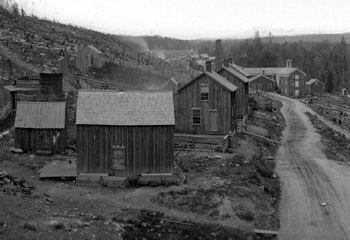 The Borough of Fall Brook showing the company store. Photo by A. B. Stebbins, courtesy blossburg.org |
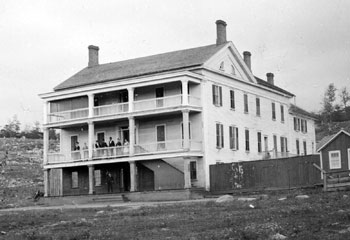 The Fall Brook Hotel Photo by A. B. Stebbins, courtesy blossburg.org | |
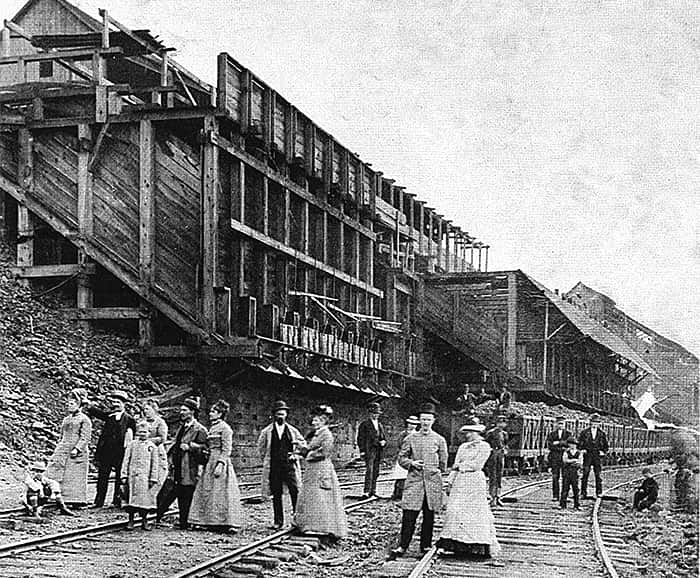 Visitors from New York City visit the Fall Brook Coal Tipples, 1880 Keith Lindie Archive Photo. This item is copyrighted and being made available on The Internet Archive with permission. All Rights Reserved. | ||
Following its primitive and rushed beginning, Fall Brook was being fast populated. A corps of carpenters was constantly employed in erecting dwellings and the necessary shops, stores and offices, so that at the close of the year 1862, there were one hundred and eighty dwellings, a school-house, three boarding houses, a company store, a saw-mill, two carpenter shops, two blacksmith shops, three weighing offices, and a population of about fourteen hundred inhabitants.
In 1864, work was begun on the Fall Brook Hotel by the Fall Brook Coal Company, and opened to the public by Warren Goff, its first manager in 1865. The telegraph line from Corning to Fall Brook was completed in the fall of 1864. A railroad depot was finished in 1865. In 1869 the Alba and Fall Brook stage line was established.
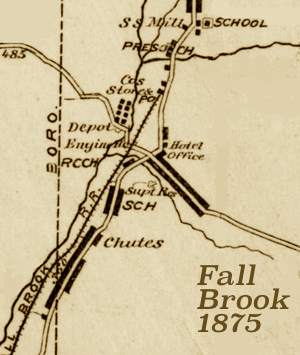 The Borough of Fall Brook, 1875 County Atlas, Tioga County PA- NY - Beers - 1875 |
The smallpox raged in Fall Brook during the winter of 1871-2, and several deaths resulted.
In 1872, fire in the woods around Fall Brook threatened the village, but the population fought it under control
Until the year 1874, Fall Brook was one of the most tidy and well appearing mining towns in northern Pennsylvania. A large number of the dwellings were painted and well repaired, occupying lots, and not in blocks as in many towns. But following the panic of 1873, business would not warrant any outlay beyond what was absolutely necessary to carry on the work. Many miners were transferred to other locations, and there were many vacant dwellings.
(Excerpted from History of Tioga County, Pennsylvania - W.W. Munsell & Co., N.Y. - 1883)
An 1883 extensive look at Fall Brook Borough History can be found online as part of Joyce Tice's wonderful History Center pages.
In the News:
September 1, 1859 - Hon, John Magee has purchased 6,000 acres, of valuable mineral land, lying six miles from Blossburg, Pa., and is now building a railroad six and one-third miles in length connecting with the Tioga Railroad at Blossburg. (Hornellsville Tribune)
April 1, 1860 - Duncan S. Magee, superintendent, announced the opening of the mines at Fall Brook, and that "the Fall Brook Coal Company had ample facilities for shipping this coal at Corning by canal and railroad, and have also arrangements for delivery directly from the mines by rail at Watkins, at the head of Seneca Lake, and there transferring it to the enlarged Erie Canal boats." (Compiled from History of Tioga County, Pennsylvania - Munsell, 1883)
August 8, 1860 - A number of citizens of Wellsboro are to make an excursion on the 5th to the Fall Brook Coal Mines, seven miles above Blossburg. They will be accompanied by a Cotillion and Brass Band. (Corning Journal)
January 22, 1863 - (John Magee) purchased 6,000 acres of land in Ward township. In the summer of 1859 he built a railroad from Fall Brook to Blossburg, of about seven miles in length, expending about $80,000 in the work. In the fall of that year he opened the coal mines and built houses about Fall Brook, in which he expended $60,000. He has upon the railroad now seven engines which are worth at a low estimate $50,000 more. In 1860 John Magee transported over this road seventy-one thousand tons of coal and provided his own cars to carry it in. In 1861 he transported over the Tioga Railroad eighty thousand tons, and in 1862 one hundred and thirty-seven thousand tons. The Tioga Railroad charges him for the use of their road 30 cents per ton, he furnished cars. (Tioga Agitator)
June 23, 1864 - The Tioga Railroad Co. and Fall Brook Coal Co. are constructing a line of Telegraph from Corning to Fall Brook. It is to be in working order by the 1st of August, and aside from its usefulness to the Companies, will be of great service to the people along the line. (Corning Journal)
September 16, 1864 - Fall Brook's petition to be incorporated as a borough was granted. The borough embraces about six thousand acres of land owned exclusively by the Fall Brook Coal Company ... it contains a population of about one-thousand persons, who are engaged in mining, lumbering, etc. ... There was a saw mill, coal chutes, thirty to forty crude dwellings, a supply store, boarding houses, blacksmith shops, and a carpenter shop along with a schoolhouse ... churches ... and a company store. In the fall of 1864, a telegraph line was completed between Corning and Fall Brook ... The Fall Brook Hotel was completed in May, 1865 ... the railroad depot opened in December 1865. (Compiled from History of Tioga County, Pennsylvania - Munsell, 1883)
View in Fall Brook, Pennsylvania, from the center of the town
November 2, 1870 - [during an excursion for several prominent Corning citizens to the Fall Brook mines] Blossburg was reached in due time and soon after the road entered a woody ravine, in which some flour miles distant reposes the station of Somerville. There is no depot, and but one house in the settlement. This is where coal trains are made up, and where the up train changes engines to ascend the steep hillside. This is only achieved by a succession of zigzags, and thus backing and proceeding the height is gradually attained until the station of Fall Brook is reached. The "village" is mostly upon a plain or sloping surface, the crest of which is covered with timber. The dwellings are small, but substantial, and most are unpainted, of those which are in that portion of the hamlet, but a half mile distant is the other "wing" of Fall Brook, where houses are regularly located, and painted a uniform color. (Corning Journal)December 8, 1870 - The commodious hotel is managed by Mr. L. Phillips, who has in his employ very faithful and courteous porters and servants. The rooms are spacious, well furnished, lighted and warmed. The beds are as good as I have ever seen in any city hotel, and table is well supplied with all the substantials and essentials, as well as most of the luxuries of the season, as good as furnished at the first class city hotels. No one will regret a visit at Fall Brook if they will tarry a day and night at the Fall Brook hotel. (Corning Journal)
April 22, 1875 - Fred S. Bragg, who has been for fourteen years a locomotive engineer at Fall Brook, drawing all coal trains between there and Somerville, has removed to Corning. He is the oldest engineer in the service of the Fall Brook Company, and is one of the most capable, as well as experienced. (Corning Journal)
February 21, 1878 - A correspondent of the Wellsboro Gazette states that Fall Brook, once having a population of fifteen hundred persons, has now but three hundred. (Corning Journal)
Visitors from New York City visit the Fall Brook #3 Drift, 1880
Keith Lindie Archive Photo. This item is copyrighted and being made available on The Internet Archive with permission.
All Rights Reserved.
May 26, 1881 - The Blossburg Register says that there are extensive improvements going on in Fall Brook. The roof of the depot is being raised one story, so as to have a good public hall. The prospectors having found a new and excellent vein of coal, and the company intends to run an extension of the railroad to it and erect schutes. Times begin to look prosperous for Fall Brook once more. A great many buildings are being painted and repaired and the hotel is being fixed up in fine manner and regaining its former popularity. (Watkins Express)
March 10, 1886 - It is said that the new mine which will be opened at Fall Brook, Pa., as soon as spring opens, contains at least two hundred thousand tons of coal of an excellent quality. (Watkins Democrat)
August 25, 1887 - We are informed that the coal at Fall Brook is not expected to hold out more than eighteen months longer, and that as soon as the supply of timber in that vicinity has become exhausted, the railroad will be taken up. Fall Brook will then become a veritable deserted village. There are about 250 tenement houses in the place .. giving a population of something over twelve hundred men, women and children who will have to look elsewhere for the means of obtaining a livelihood. (Mansfield Advertiser)
January 18, 1894 - After being out on strike for ten days and losing $35,000 in wages, the coal miners of Arnot, Fall Brook and Morris Run, in the Blossburg coal region of Pennsylvania, went to work again Monday January 8th accepting a ten percent reduction in wages. (Watkins Express)
July 8, 1896 - The Fall Brook Coal Company is reopening the old No. 1 drift at Fall Brook, building new schusses and preparing to make other marked improvements about the mines there. (Wellsboro Agitator)
May 17, 1899 - Last Sunday morning the hotel at Fall Brook was destroyed by fire, with a large part of its contents. (Wellsboro Agitator)
August 30, 1899 - Fall Brook's miners on August 18th laid down their tools. (Wellsboro Agitator)
October 27, 1899 - The Mansfield Advertiser says that henceforth Fall Brook will not figure among the mining towns of this county. It has been abandoned by the new owners, presumably for all time. The few people remaining there are moving away. (Wellsboro Agitator)
July 22, 1942 - Fall Brook, Ghost Town, comes to life August 2. Plans are going forward for one of this area's traditional celebrations, the ninth annual Fall Brook, Pa. reunion scheduled Sunday, August 2. Once a thriving and thickly settled community, Fall Brook is now one of Pennsylvania's ghost town. (Corning Evening Leader)
2021 - A brief video tour of the Fall Brook Cemetery is available on YouTube
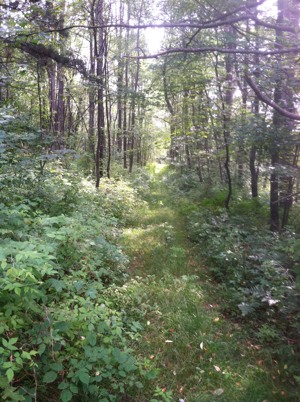
Looking south along the old Fall Brook railbed
Photo: Steve Ensminger Jr., 2014
